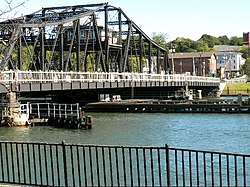Bridges
| Name (Alternate name) | Location | Image | Completed/Replaced | NRHP [1] : 78 | HAER [1] : 79 |
|---|---|---|---|---|---|
| Congress Street Bridge | Bridgeport | 1909-1911; [1] : 22 Removed in 2010 [3] | |||
| East Washington Avenue Bridge | Bridgeport | Original: 1836 [4] Second: Unknown [4] Third: 1925 [4] Fourth: 1998 [1] : 24 | CT-154 (third bridge) | ||
| Grand Street Bridge | Bridgeport |  | 1916-1919; [1] : 26 Removed in 1999 [5] | CT-148 | |
| Pequonnock River Railroad Bridge | Bridgeport |  | 1902; Replaced in 1996 [1] : 50 | 87000843 | |
| Pleasure Beach Bridge | Bridgeport | 1927 [1] : 20 | |||
| Yellow Mill Bridge | Bridgeport | 1927-1929 [1] : 28 | CT-146 | ||
| East Haddam Swing Bridge | East Haddam-Haddam | 1913 [1] : 30 | |||
| Niantic River Swing Bridge | East Lyme-Waterford | 1921; Replaced in 1991 [1] : 32 | CT-22 | ||
| Niantic River Railroad Bridge | East Lyme-Waterford |  | 1907; [1] : 52 Replaced 2010-2013 [6] | CT-27 | |
| Mianus River Railroad Bridge | Greenwich |  | 1904 [1] : 54 | 87000845 | |
| Thames River Railroad Bridge | Groton-New London |  | 1919 [note 1] Replaced 2008 [8] | CT-25 | |
| Mystic River Bridge | Groton-Stonington |  | 1922 [1] : 34 | CT-174 | |
| Mystic River Railroad Bridge | Groton-Stonington |  | 1919; Replaced 1984 [1] : 58 | CT-26 | |
| Middletown Railroad Bridge | Middletown-Portland | 1911 [1] : 60 | |||
| Housatonic River Railroad Bridge | Milford-Stratford |  | 1905 [1] : 62 | 87000842 | |
| Washington Bridge | Milford-Stratford |  | 1921 [1] : 36 | ||
| Chapel Street Swing Bridge | New Haven |  | 1899; Replaced 1992 [1] : 38 | CT-42 | |
| Ferry Street Bridge | New Haven |  | 1940 [1] : 40 | ||
| Grand Avenue Swing Bridge | New Haven |  | 1896; Replaced 1984 [1] : 44 | ||
| Tomlinson Bridge | New Haven |  | 1924; Replaced 1994-2002 [1] : 42 | CT-61 | |
| Shaw's Cove Railroad Bridge | New London | 1891; Replaced 1984 [1] : 64 | CT-24 | ||
| Norwalk River Railroad Bridge | Norwalk |  | 1896 [1] : 66 | 87000844 | |
| Amtrak Old Saybrook–Old Lyme Bridge | Old Saybrook-Old Lyme |  | 1907 [1] : 68 | ||
| Saugatuck River Bridge | Westport |  | 1884 [1] : 46 | 87000846 | CT-46 |
| Saugatuck River Railroad Bridge | Westport |  | 1905 [1] : 70 | 87000126 | |
- NRHP - National Register of Historic Places listed
- HAER - Historic American Engineering Record listed